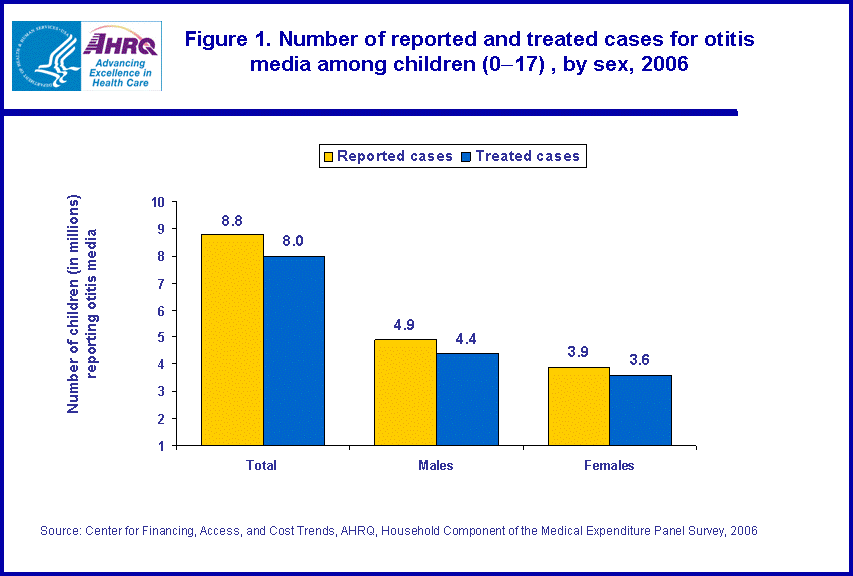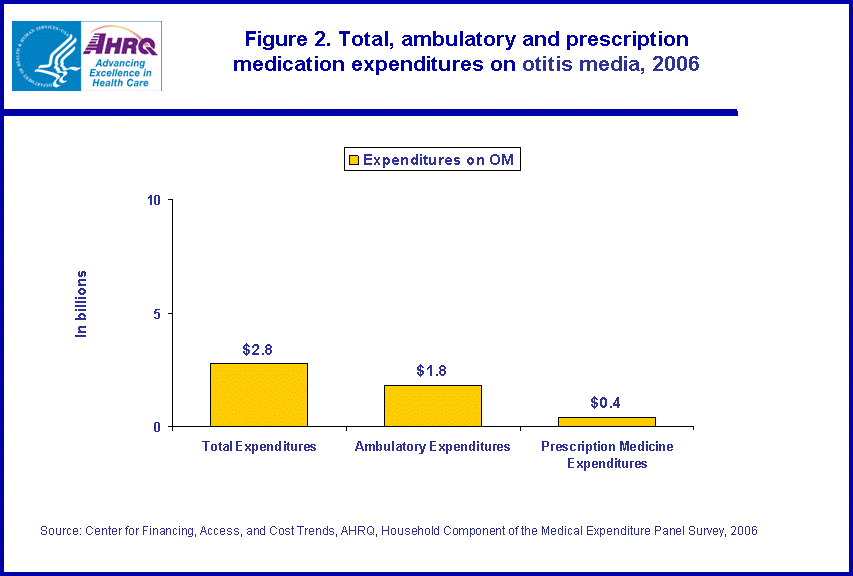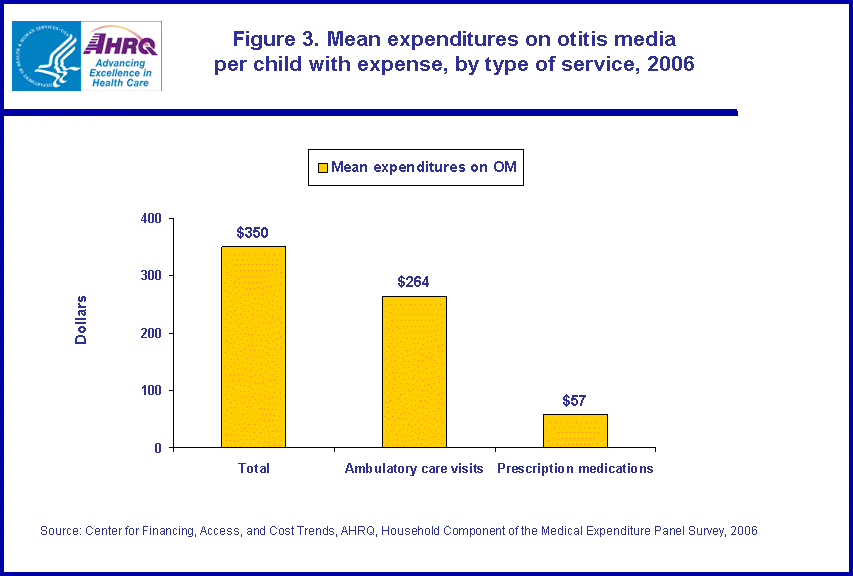
|
|
Font Size:
|
||||
|
|
|
|
||||
STATISTICAL BRIEF #228:
Ear Infections (Otitis Media) in Children (0-17): Use and Expenditures, 2006
Highlights
- In 2006, approximately 9 million children, ages 0-17, reported to have ear infections or otitis media. Of those, 8 million children reported visiting a physician or obtaining a prescription drug to treat the condition.
- Medical spending to treat otitis media totaled $2.8 billion in 2006.
- Mean annual expenditures for those with an expense related to otitis media were $350 per person.
- More than one-third of ear infection prescription medications expenditures were paid from out of pocket.
Introduction
Otitis media, also known as an ear infection, occurs in the space behind the eardrum, which is called the middle ear. Ear infections are more likely to occur after a cold, or other upper respiratory infection, has been present for a few days.
During a cold, throat infection, or allergy attack, the tube that connects the throat and the middle ear (eustachian tube) swells and prevents air from entering the middle ear. This can create suction, which pulls fluid into the middle ear space. The fluid becomes trapped in the middle ear, allowing viruses or bacteria to grow and cause infection.
Ear infections are most common in children younger than age 7. Young children have shorter, softer, and more horizontal eustachian tubes, which are blocked more easily than those of older children and adults. Symptoms of ear infection can include ear pain, fever, thick and yellow drainage from the ear, irritability, loss of appetite, vomiting, difficulty sleeping, and trouble hearing.
This Statistical Brief presents estimates based on the Household Component of the Medical Expenditure Panel Survey (MEPS-HC) on the use of and expenditures for ambulatory care and prescribed medications to treat otitis media among children ages 0-17 in the U.S. civilian noninstitutionalized population. Average annual estimates are shown by type of service and source of payment. All differences between estimates noted in the text are statistically significant at the 0.05 level or better.
Findings
Number of reported cases for otitis media, by sex
In 2006, 8.8 million (11.8 percent) of U.S. children under age 18 reported to have ear infections or otitis media (figure 1). Of those, 8 million children (10.8 percent) reported visiting a physician or obtaining a prescription drug to treat the condition. More male children reported experiencing otitis media than female children (4.9 million versus 3.9 million).
Total and mean health care expenditures on otitis media, by type of service
A total of $2.8 billion was spent on treatment of otitis media (not including over-the-counter medications) (figure 2). A higher percentage of these expenditures was spent on ambulatory visits compared to prescription medications ($1.8 billion versus $.4 billion).
Average expenditures for those with an otitis media related expense were $350 in 2006. The mean per child expenditure on ambulatory visits was $264 compared with $57 for prescription medications (figure 3).
Distribution of average annual health care expenditures for otitis media, by source of payment and type of service
Most of the expenditures on otitis media in 2006 were paid by private insurance, 42 percent, followed by Medicaid/SCHIP paying 25 percent. Private insurance paid for more than half (51 percent) of ambulatory visit expenditures, and Medicaid/SCHIP paid one-fifth (21 percent). For prescription medications, 44 percent was paid for by private insurance compared to less than one-fifth (18.5 percent) by Medicaid/SCHIP (figure 4). More than one-third (35.2 percent) of expenses for prescribed medications were paid out of pocket.
Data Source
The estimates shown in this Statistical Brief are based on data from the MEPS 2006 Full Year Consolidated File (HC-105), Medical Condition File (HC-104), Office-Based Medical Provider Visit File (HC-102G), Outpatient Department Visits File (HC-102F), Hospital In-Patient Stays File (HC-102D), Home Health File (HC-102H), Emergency Room Visit File (HC-102E), and Prescribed Medicine File (HC-102A).
Definitions
Otitis media
This brief analyzes individuals, ages 0-17 with otitis media reported as a condition bothering the person, as well as otitis media reported in connection with reported health care utilization or reported disability days. The conditions reported by respondents were recorded by interviewers as verbatim text, which was then coded by professional coders to fully specified ICD-9-CM codes. Conditions with ICD-9 codes of 381 and 382 were classified as otitis media.
Expenditures
Expenditures in MEPS are defined as payments from all sources for hospital inpatient care, ambulatory care provided in offices and hospital outpatient departments, care provided in emergency departments, as well as prescribed medicine purchases reported by respondents in the MEPS-HC. Sources include direct payments from individuals, private insurance, Medicare, Medicaid/State Children's Health Insurance Program (SCHIP), Workers' Compensation, and miscellaneous other sources.
These expenditures do not include 'over-the-counter' medications used for treatment of otitis media.
About MEPS
MEPS-HC is a nationally representative longitudinal survey that collects detailed information on health care utilization and expenditures, health insurance, and health status, as well as a wide variety of social, demographic, and economic characteristics for the civilian noninstitutionalized population. It is cosponsored by the Agency for Healthcare Research and Quality and the National Center for Health Statistics.
For more information about MEPS, call the MEPS information coordinator at AHRQ (301-427-1656) or visit the MEPS Web site at http://www.meps.ahrq.gov/.
References
For a detailed description of the MEPS-HC survey design, sample design, and methods used to minimize sources of nonsampling errors, see the following publications:
Cohen, J. Design and Methods of the Medical Expenditure Panel Survey Household Component. MEPS Methodology Report No. 1. AHCPR Pub. No. 97-0026. Rockville, MD: Agency for Health Care Policy and Research, 1997. http://www.meps.ahrq.gov/mepsweb/data_files/publications/mr1/mr1.shtml
Cohen, S. Sample Design of the 1996 Medical Expenditure Panel Survey Household Component. MEPS Methodology Report No. 2. AHCPR Pub. No. 97-0027. Rockville, MD: Agency for Health Care Policy and Research, 1997. http://www.meps.ahrq.gov/mepsweb/data_files/publications/mr2/mr2.shtml.
Cohen, S. Design Strategies and Innovations in the Medical Expenditure Panel Survey. Medical Care, July 2003: 41(7) Supplement: III-5-III-12.
For more information about otitis media, see the following publications:
Otitis Media: National Institute on Deafness and other Communication Disorders. Available at: http://www.nidcd.nih.gov/health/hearing/otitism.asp
What is middle ear infection? http://www.ehealthmd.com/library/middleear/MEI_whatis.html
Ear infections: http://www.webmd.com/cold-and-flu/ear-infection/ear-infections-topic-overview
What is ear infection? http://kidshealth.org/kid/ill_injure/sick/ear_infection.html
Suggested Citation
Soni, A. Ear Infections (Otitis Media) in Children (0-17): Use and Expenditures, 2006. Statistical Brief #228. December 2008. Agency for Healthcare Research and Quality, Rockville, MD, http://www.meps.ahrq.gov/mepsweb/data_files/publications/st228/stat228.shtml.
AHRQ welcomes questions and comments from readers of this publication who are interested in obtaining more information about access, cost, use, financing, and quality of health care in the United States. We also invite you to tell us how you are using this Statistical Brief and other MEPS data and tools and to share suggestions on how MEPS products might be enhanced to further meet your needs. Please e-mail us at mepspd@ahrq.gov or send a letter to the address below:
Steven B. Cohen, PhD, Director
Center for Financing, Access, and Cost Trends
Agency for Healthcare Research and Quality
540 Gaither Road
Rockville, MD 20850
 |
||||||||||||||||||||||||||||
|
||||||||||||||||||||||||||||
|
|
||||||||||||||||||||||||||||
 |
||||||||||||||||||||||||||||
|
||||||||||||||||||||||||||||
|
|
||||||||||||||||||||||||||||
 |
||||||||||||||||||||||||||||
|
||||||||||||||||||||||||||||
|
|
||||||||||||||||||||||||||||
 |
||||||||||||||||||||||||||||
|
||||||||||||||||||||||||||||
|
|
||||||||||||||||||||||||||||


